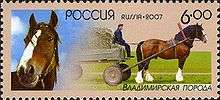Vladimir Heavy Draft
The Vladimir Heavy Draft is a Russian breed of heavy draught horse. It was bred in the early twentieth century in farms and collectives in Ivanovo Oblast and Vladimir Oblast, to the east of Moscow. The most important influence on the development of the breed was from three Clydesdale stallions foaled between 1910 and 1923. The Vladimir was officially recognised in 1946.
 Vladimir Heavy Draft on a Russian stamp | |
| Conservation status | FAO (2007): not at risk[1]:99 |
|---|---|
| Other names | |
| Country of origin | Russian Federation |
| Use | draught, meat[3]:511 |
| Traits | |
| Weight |
|
| Height | |
History
The Russian Empire had no indigenous breeds of heavy draught horse. The Vladimir was created at about the same time as the development of the Russian Heavy Draught in Ukraine.[5]:277
The foundations of the Vladimir breed were laid between 1886 and 1924.[2] Initial breeding began at the stud farm of Gavrilov Posad, in Ivanovo Oblast, where local horses were cross-bred with imported Clydesdale stock, with some limited influence from Cleveland Bay, Percheron and Suffolk Punch.[3]:511[5]:276 Some use was made of Shire mares between 1919 and 1929.[5]:276[4]:327 The three foundation stallions of the breed were all Clydesdales. Two of these – Border Brand and Lord James – were foaled in 1910, while Glen Albin was born in 1923.[5]:276
The amount of cross-breeding was progressively reduced during the 1920s, and over the next twenty years the character and type of the breed were fixed. Official recognition came in 1946.[5]:276
Characteristics
The Vladimir is a draught horse of medium power, with energetic and active gaits.[4]:327 It is more solidly built than the Clydesdale, and unusually deep in the girth – thoracic circumference may reach 2.07 m. It is usually clean-legged, though feathering can occur. Bay is the most usual colour,[5]:276 with white markings to the face and legs.[4]:327
Use
The Vladimir was bred for agricultural draught work. It may be reared for meat.[3]:511 It is fast-growing: at six months, foals may reach a weight of 200 kg.[4]:327 Because of its lively movement, it is found suitable for pulling the three-horse troika of the region.[5]:276
References
| Wikimedia Commons has media related to Vladimir Heavy Draft. |
- Barbara Rischkowsky, D. Pilling (eds.) (2007). List of breeds documented in the Global Databank for Animal Genetic Resources, annex to The State of the World's Animal Genetic Resources for Food and Agriculture. Rome: Food and Agriculture Organization of the United Nations. ISBN 9789251057629. Accessed June 2017.
- Vladimirskaya Tyazhelovoznaya/Russian Federation. Domestic Animal Diversity Information System of the Food and Agriculture Organization of the United Nations. Accessed June 2017.
- Valerie Porter, Lawrence Alderson, Stephen J.G. Hall, D. Phillip Sponenberg (2016). Mason's World Encyclopedia of Livestock Breeds and Breeding (sixth edition). Wallingford: CABI. ISBN 9781780647944.
- N.G. Dmitriev, L.K. Ernst (1989). Animal genetic resources of the USSR. FAO animal production and health paper 65. Rome: Food and Agriculture Organization of the United Nations. ISBN 9251025827. Archived 13 November 2009. Also available here, archived 29 September 2017.
- Elwyn Hartley Edwards (1994). The Encyclopedia of the Horse. London; New York; Stuttgart; Moscow: Dorling Kindersley. ISBN 0751301159.